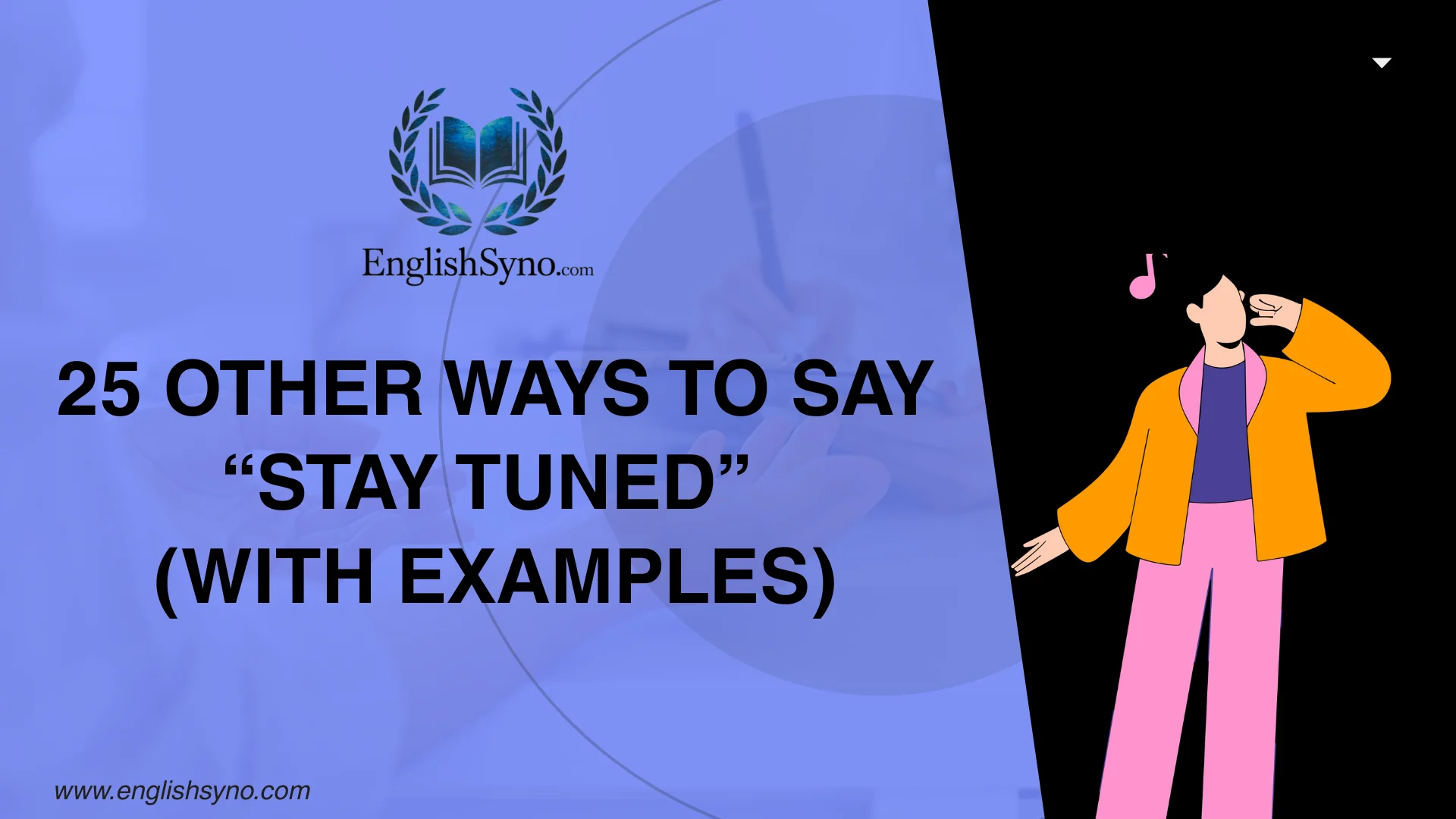In my experience, Stay Tuned is more than an idiom; it’s a gentle nudge to keep paying attention because more information or new developments will soon be shared, encouraging viewers to stay engaged.
This expression originated in broadcasting to encourage viewers to stick with the same channel during a commercial break, but today it’s used widely across media to indicate that something interesting or important will follow, whether watching TV, listening to the radio, or following a live broadcast.
In modern online contexts, like platforms such as YouTube, stay tuned signals upcoming content, including a live stream, future video, or other updates, helping the audience know when content is going live, ensuring they don’t miss important developments while engagement rises and viewers feel included in the next steps of a project or subject.
What Does “Stay Tuned” Mean?
Definition & Meaning: “Stay Tuned” is an idiom used to encourage someone to keep paying attention because more information, updates, or developments will soon be shared. It originated in broadcasting, where viewers were asked to stay on the same channel during a commercial break.
Detailed Explanation & Example:
For instance, a news anchor might say, “Stay tuned for a special report after the break,” signaling that something important is coming.
When to Use “Stay Tuned”
Definition & Meaning: It’s best used when there is upcoming content, updates, or new information that your audience will benefit from.
Detailed Explanation & Example:
On YouTube, a creator might say, “Stay tuned for the next live stream,” creating excitement and anticipation.
Is It Professional/Polite to Say “Stay Tuned”?
Definition & Meaning: Yes, it is professional when used in the right context, signaling anticipation without demanding immediate action.
Detailed Explanation & Example:
In a corporate meeting, you could say, “Stay tuned for updates on the project timeline,” keeping colleagues engaged respectfully.
Pros or Cons
Pros:
- Encourages attention and engagement
- Signals upcoming updates
- Versatile in media and conversation
Cons:
- Can feel vague if overused
- May cause frustration if no follow-up occurs
Keep Watching
Definition & Meaning: Encourages the audience to continue paying attention for upcoming content or news.
Detailed Explanation & Example:
On a TV show, a host might say, “Keep watching as we reveal the winner of the contest.”
Best Use: TV, video content, online streams.
Worst Use: Emails or messaging without follow-up.
Tone: Engaging, casual, anticipatory.
More to Come
Definition & Meaning: Signals that additional information or developments are forthcoming.
Detailed Explanation & Example:
A newsletter might close with, “More to come in next week’s edition,” keeping subscribers interested.
Best Use: Newsletters, announcements, social media posts.
Worst Use: Overused in conversations without a clear next step.
Tone: Informative, friendly, anticipatory.
Updates Soon
Definition & Meaning: Indicates that fresh information or news will be provided shortly.
Detailed Explanation & Example:
A company may tweet, “Updates soon on our product launch,” signaling readers to check back.
Best Use: Corporate communications, product updates, social media.
Worst Use: Without a timeline, it can feel vague or careless.
Tone: Professional, anticipatory, polite.
Coming Up Next
Definition & Meaning: Highlights what will happen immediately after the current segment.
Detailed Explanation & Example:
On TV: “Coming up next, a special interview with the CEO.”
Best Use: Broadcast, live streams, events.
Worst Use: Messaging or emails without context.
Tone: Engaging, informative, clear.
Don’t Miss Out
Definition & Meaning: Creates a sense of urgency to keep attention or participate.
Detailed Explanation & Example:
A brand may post, “Don’t miss out on our exclusive webinar,” prompting immediate interest.
Best Use: Marketing, promotions, live events.
Worst Use: Casual or overly frequent use can feel pushy.
Tone: Exciting, persuasive, engaging.
Stay Alert
Definition & Meaning: Encourages someone to remain attentive for updates or new developments.
Detailed Explanation & Example:
A company newsletter might say, “Stay alert for the latest software updates,” signaling employees to watch for important information.
Best Use: Professional communications, online announcements.
Worst Use: Casual conversations; can feel overly formal.
Tone: Professional, anticipatory, clear.
Check Back Soon
Definition & Meaning: Suggests returning later to see new content or updates.
Detailed Explanation & Example:
A blog post might end with, “Check back soon for the next chapter of the story.”
Best Use: Websites, blogs, social media updates.
Worst Use: Text messages with no scheduled update.
Tone: Friendly, polite, engaging.
Keep an Eye Out
Definition & Meaning: Tells someone to look for important or upcoming information.
Detailed Explanation & Example:
An event organizer might say, “Keep an eye out for our event schedule announcement.”
Best Use: Event updates, social media teasers.
Worst Use: Overused casually; may seem vague.
Tone: Casual, anticipatory, friendly.
More Coming
Definition & Meaning: Signals that additional details or content will soon be available.
Detailed Explanation & Example:
A newsletter could close with, “More coming in next week’s edition, so don’t miss it.”
Best Use: Newsletters, blogs, email updates.
Worst Use: Incomplete updates; no clear follow-up.
Tone: Friendly, engaging, anticipatory.
Hang Tight
Definition & Meaning: A casual way to ask someone to wait patiently for upcoming information.
Detailed Explanation & Example:
A YouTuber might say, “Hang tight while we prepare the next video.”
Best Use: Online videos, social media, casual updates.
Worst Use: Formal emails or professional announcements.
Tone: Casual, friendly, supportive.
Watch This Space
Definition & Meaning: Indicates that important updates or developments will appear soon.
Detailed Explanation & Example:
A brand could post on Instagram, “Watch this space for our new product launch.”
Best Use: Social media, marketing campaigns.
Worst Use: Emails without updates; can feel vague.
Tone: Engaging, anticipatory, modern.
Await Updates
Definition & Meaning: Tells the audience to expect new information soon.
Detailed Explanation & Example:
A corporate email might say, “Await updates on project deadlines.”
Best Use: Professional announcements, internal communications.
Worst Use: Casual messaging; may feel stiff.
Tone: Professional, polite, informative.
On the Horizon
Definition & Meaning: Suggests that something important is coming soon.
Detailed Explanation & Example:
A blog may state, “On the horizon: our upcoming guide to marketing trends.”
Best Use: Blogs, newsletters, professional content.
Worst Use: Messages with no timeline; vague context.
Tone: Engaging, anticipatory, professional.
Future Content
Definition & Meaning: Highlights that new material or information will be shared later.
Detailed Explanation & Example:
A YouTube creator might say, “Future content includes tutorials and tips you won’t want to miss.”
Best Use: Online channels, courses, blogs.
Worst Use: Casual chats; can sound formal.
Tone: Informative, engaging, anticipatory.
Preview Coming
Definition & Meaning: Signals that a teaser or sample of content will be available soon.
Detailed Explanation & Example:
A streaming service may post, “Preview coming of our new series episode.”
Best Use: Media announcements, social media.
Worst Use: Emails or texts without follow-up.
Tone: Exciting, engaging, anticipatory.
Don’t Miss What’s Next
Definition & Meaning: Encourages the audience to pay attention to upcoming content.
Detailed Explanation & Example:
A podcast host may say, “Don’t miss what’s next in our discussion on health tips.”
Best Use: Podcasts, live streams, webinars.
Worst Use: Overuse in casual text messages.
Tone: Engaging, anticipatory, persuasive.
Keep Posted
Definition & Meaning: Suggests the audience stay informed about updates.
Detailed Explanation & Example:
A team lead might say, “Keep posted for changes to the meeting schedule.”
Best Use: Professional updates, team communication.
Worst Use: Social media; may sound formal.
Tone: Professional, polite, informative.
Stay Informed
Definition & Meaning: Encourages maintaining awareness of developments or news.
Detailed Explanation & Example:
A newsletter might advise, “Stay informed about market trends this week.”
Best Use: News, professional updates.
Worst Use: Casual conversations; may feel stiff.
Tone: Professional, formal, informative.
Don’t Miss the Update
Definition & Meaning: Alerts readers to critical or timely information.
Detailed Explanation & Example:
An email campaign might say, “Don’t miss the update on our product release.”
Best Use: Marketing, announcements, online platforms.
Worst Use: Casual chats; may feel pushy.
Tone: Urgent, persuasive, anticipatory.
Next Up
Definition & Meaning: Shows what content or information will be presented immediately next.
Detailed Explanation & Example:
A live stream host may say, “Next up, a Q&A session with our experts.”
Best Use: Broadcasts, live streams, webinars.
Worst Use: Casual emails; may confuse readers.
Tone: Clear, engaging, anticipatory.
Stay Posted for News
Definition & Meaning: Encourages ongoing attention for upcoming announcements or updates.
Detailed Explanation & Example:
A brand may tweet, “Stay posted for news about our holiday offers.”
Best Use: Social media, marketing campaigns.
Worst Use: Overuse without updates.
Tone: Engaging, professional, anticipatory.
Keep Your Eyes Open
Definition & Meaning: A casual way to watch for important developments.
Detailed Explanation & Example:
A coach might say, “Keep your eyes open for the next drill instructions.”
Best Use: Educational content, casual guidance.
Worst Use: Professional emails; may feel informal.
Tone: Friendly, anticipatory, casual.
Watch Out for Updates
Definition & Meaning: Suggests looking carefully for new information.
Detailed Explanation & Example:
A company may post, “Watch out for updates on our website redesign.”
Best Use: Social media, blogs, newsletters.
Worst Use: Casual texts with no context.
Tone: Professional, friendly, anticipatory.
Hold Tight
Definition & Meaning: Asks the audience to be patient until new information is available.
Detailed Explanation & Example:
A streaming platform might say, “Hold tight as we load the next episode.”
Best Use: Online videos, live streams, announcements.
Worst Use: Formal emails; may feel too casual.
Tone: Casual, supportive, friendly.
Keep Watching for More
Definition & Meaning: Encourages the audience to continue observing for additional updates or developments.
Detailed Explanation & Example:
A YouTube creator might say, “Keep watching for more tutorials on graphic design tips.”
Best Use: Online videos, social media, streaming content.
Worst Use: Casual texts without follow-up.
Tone: Engaging, anticipatory, informative.
Final Thoughts
Expressing the idea of “Stay Tuned” in different ways allows you to connect with your audience more thoughtfully and meaningfully. Words carry tone, anticipation, and engagement, and choosing the right phrase can make your message feel personal, professional, or friendly depending on the context. Whether you are communicating through TV broadcasts, radio, online platforms like YouTube, or emails, the right wording ensures your audience understands that more information, updates, or important developments are coming.
Using alternatives like “Keep Watching,” “More to Come,” “Watch This Space,” or “Hang Tight” creates a sense of excitement and anticipation. It also demonstrates that you value the attention and patience of your audience. Overusing the phrase without providing real updates can lead to frustration, so timing and clarity are essential. By thoughtfully selecting your words, you can signal upcoming content, engage your audience, and maintain trust.
In professional contexts, phrases like “Stay Posted” or “Await Updates” convey politeness and professionalism, while casual expressions like “Hang Tight” or “Keep an Eye Out” add a friendly, conversational tone. Social media, newsletters, and live streaming particularly benefit from these variations, as they keep users engaged without seeming repetitive.
Ultimately, learning to use multiple ways to say “Stay Tuned” allows you to craft messages that are clear, empathetic, and compelling, ensuring your audience remains interested, informed, and ready for what’s next, creating better engagement and stronger communication in any medium.
FAQs
What does “Stay Tuned” mean?
“Stay Tuned” is an idiom used to ask someone to keep paying attention for upcoming updates or new information, often in media or conversation.
When should I use “Stay Tuned”?
Use it when more information, updates, or developments are coming soon, such as during broadcasts, online content, or professional announcements.
Is “Stay Tuned” professional?
Yes, it can be professional and polite if used in contexts like meetings, emails, or newsletters. Avoid casual overuse.
Can I use it on social media?
Absolutely. On platforms like YouTube, Instagram, or Twitter, “Stay Tuned” helps engage the audience and signal upcoming content.
What are alternatives to “Stay Tuned”?
Some alternatives include Keep Watching, More to Come, Hang Tight, Watch This Space, and Await Updates, depending on tone and medium.
How do I make it engaging?
Pair the phrase with teasers or hints about upcoming content to generate excitement and anticipation for your audience.
Can it feel vague?
Yes, overuse without real updates can seem unclear or frustrating, so always follow up with actual content or news.
Is it casual or formal?
It can be both. Phrases like “Hang Tight” are casual, while “Stay Posted” or “Await Updates” are formal.
Does it work for emails?
Yes, particularly in newsletters or professional updates where future information is relevant and anticipated.
How does it affect engagement?
Using “Stay Tuned” and alternatives increases audience attention, anticipation, and trust, keeping them invested in your message.
Can it be used in meetings?
Yes. During presentations, saying “Stay Tuned for the next steps” helps maintain focus and signals upcoming important details.
What tone should I use?
The tone can be friendly, professional, anticipatory, or casual, depending on your audience and context.
Should I always follow up?
Absolutely. Following up ensures credibility, avoids frustration, and confirms the audience receives the promised updates.
Does it work internationally?
Yes, idioms like “Stay Tuned” are widely understood in media contexts globally, especially in English-speaking platforms.
Can I mix alternatives?
Yes, mixing phrases like “Keep Watching” or “Watch This Space” can maintain variety, engagement, and excitement across different media channels.



